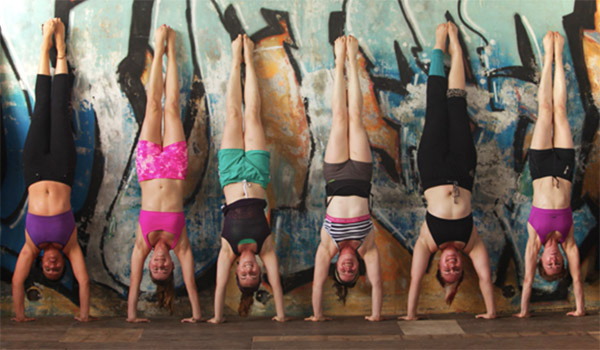Handstands are one of those things we could all do when we were kids – or at least attempt – without fear of falling. Now we’re all grown up, and a lot of adults, even fairly fit ones, are afraid of turning upside down and potentially landing on their heads.
The biggest hurdle to learning how to handstand, at least in the initial stages, is confidence and overcoming the fear associated with turning upside down. If you’ve been out of practice doing handstand for several decades or maybe you’ve never even tried to do one, then you’ll need to start slowly to build up your confidence when standing on your hands.
Locking Elbows
The main thing beginners need to learn to do, is lock their elbows. If you’re elbows are locked when you swing upwards you are locked onto a swing in a pendulum type of movement. Your head will always stay the same distance from your hands, and you will never land flat on your face. As long as people are aware of this and maintain their elbow lock when learning, they will not suffer from that dreaded fall onto their face.
To build confidence initially first you should practice swinging up against a wall. With help, most people can get into a typical handstand pose while leaning against a wall, and this can help build confidence too. If you have a partner or gym buddy who is willing to help you achieve inversion, have them assist you in turning upside down, leading against a wall to help you get used to the feeling of being upside down.
Wrist Strength
If your hands or wrists feel sore while practicing, consider using handstand blocks to ease the strain on your joints and keep you more comfortable while your feet are up in the air. Another important tip is to practice on soft ground, just in case you do fall. Soft matting, a floor mattress, or grass are all good choices for grounding while you’re learning these skills.
Once you have a comfortable space to practice in, and feel confident you can lock your elbows and keep them locked, you can practice the movement of going up into a handstand by putting your hands on the ground near a wall, and swinging your legs up in the air.
Leg Positioning
Beginners usually find it easier to have one leg straight and one leg bent when making this movement. The straight leg is so that if you have enough upward momentum you will land against the wall with at least one leg fully extended, and the bent leg is so that if you fall back down to the ground the foot of the leg with the bent knee will land first, and absorb the impact. One downward impact on your knee and you’ll never make that mistake ever again, but it’s better if you just learn without having to suffer through the pain of this.
Practice, Practice, Practice!
Once you have practiced this pendulum movement, with your elbows locked over and over, you should be able to go higher and higher each time. If your arms get tired take a break, and come back and try again in a few hours. The more you practice this movement the better you’ll get.
Once you have achieved a handstand against a wall, you can practice holding this pose with your feel against the wall for as long as you can. This will also help your balance, and over time you will be able to hold yourself slightly off the wall for longer and longer.
This is the best way to learn how to do a handstand. There are a lot of complimentary exercises you can do at the gym or at home to strengthen your core, practice being balanced, and increase shoulder strength etc. but this is the main exercise you should focus on to become proficient at doing handstands.
For more tips on and information of fitness and health, see http://www.myguide2life.com.
